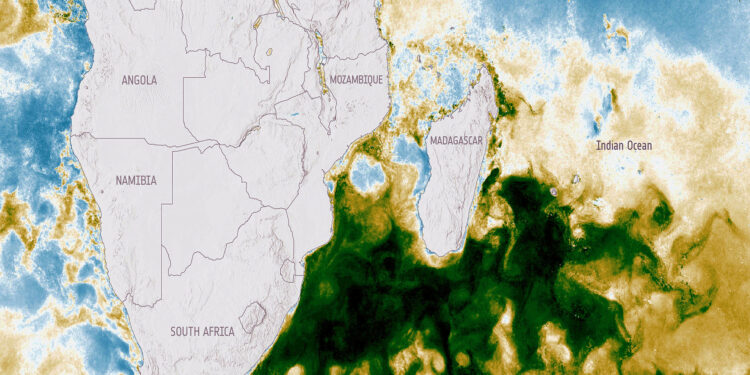The Hidden Impact of Dust: How Southern Africa’s Winds Affected Ocean Life
Imagine, for a moment, a gust from southern Africa stirring up minute particles of dust and casting them across the expansive Indian Ocean. In 2019, this natural phenomenon led to astonishing consequences, triggering the most significant phytoplankton bloom seen in two decades during a period typically devoid of such activity.
The Nutrient Journey of Dust
Often dismissed as an everyday annoyance, dust harbors unforeseen benefits. These particulate clouds can travel vast distances—including over oceans. A prime example is the fine particles from the Sahara Desert that make long journeys across the Atlantic to reach South America. When these tiny fragments settle on land or marine environments, they provide critical nutrients that promote vegetation growth on land and boost ocean productivity—serving as a vital source of nourishment for marine phytoplankton.
Exploring Connections Between Dust and Oceans
While it is acknowledged that dust travels vast distances with potential ecological impacts, the complex interrelations among desertification processes, dust dispersal events, and subsequent ocean fertilization remain largely enigmatic. Recent research published in PNAS Nexus adds valuable insights to this intricate web.
An Uncommon Phytoplankton Bloom
A research team involving scientists from ESA’s Living Planet Fellowships Poseidon and Pyroplankton identified an extraordinary bloom off southern Africa’s eastern coastline. This event was initiated by what is known as “dust wet deposition”—or rain that carries dust—occurring in nutrient-poor waters located southeast of Madagascar. Spearheaded by Dr. John Gittings from the University of Athens, this study significantly advanced our understanding of this remarkable incident.
Tracing Dust’s Path to Marine Environments
Utilizing data gathered from multiple Earth observation programs spearheaded by ESA—including initiatives focusing on ocean color and soil moisture—the research team managed to delineate the extent of this extensive phytoplankton bloom while pinpointing specific dust events responsible for its occurrence. This collaboration also involved contributions from services dedicated to atmosphere monitoring and marine research within Europe’s Copernicus program.
Climate Change Implications: Increased Dust Emissions?
Dr. Gittings highlighted that while this expansive phytoplankton boom was atypical; trends suggesting rising temperatures alongside increasing aridity in southern Africa may indicate future occurrences could become more frequent due to climate change factors like increased droughts exacerbated by aerosols traced back to wildfire events elsewhere.
– How can satellite data be used to study phytoplankton trends?
How African Dust Ignited a Thriving Phytoplankton Bloom: Nature’s Spectacular Chain Reaction
Understanding the Role of African Dust in Marine Environments
African dust is not just a nuisance; it plays a crucial role in our planet’s ecosystems. Originating from the Sahara Desert, these fine particles travel thousands of miles across the Atlantic Ocean, directly impacting sea surface conditions and nutrient availability.
What is Phytoplankton?
Phytoplankton are microscopic organisms that inhabit the upper layers of the oceans, lakes, and other bodies of water. As primary producers, they are fundamental to the aquatic food web, forming the base of all marine food chains.
The Importance of Phytoplankton Blooms
- Oxygen Production: Phytoplankton contribute to about 50% of the Earth’s oxygen supply.
- Carbon Sequestration: They play a vital role in the global carbon cycle, absorbing carbon dioxide as they grow.
- Biodiversity Support: Phytoplankton blooms support diverse marine life, from fish to larger mammals.
The Mechanism Behind the Dust-Phytoplankton Connection
The relationship between African dust and phytoplankton blooms is a prime example of nature’s interconnectedness. When dust particles accumulate in ocean waters, they bring with them vital nutrients, particularly iron, phosphorous, and nitrogen. Below are specific ways in which this process occurs:
1. Nutrient Enrichment
The primary mechanism is nutrient enrichment. African dust contains essential minerals that, when deposited into ocean waters, stimulate precise phytoplankton growth.
- Iron: A crucial micronutrient, iron stimulates phytoplankton productivity.
- Phosphorous and Nitrogen: These macronutrients help in cellular growth and reproduction.
2. Ocean Circulation and Weather Patterns
The path of African dust is influenced by specific weather patterns and ocean currents, which play a significant role in determining where and when phytoplankton blooms occur.
Case Studies in Phytoplankton Blooms
Multiple research studies illustrate the crucial link between African dust and phytoplankton growth.
Case Study: The 2015 Bloom in the Gulf of Mexico
In 2015, researchers noted a substantial phytoplankton bloom in the Gulf of Mexico following a profuse dust event from the Sahara. Satellite imagery revealed:
| Month | Dust Concentration (µg/m³) | Phytoplankton Biomass (mg/m³) |
|---|---|---|
| June | 500 | 20 |
| July | 600 | 45 |
| August | 450 | 15 |
This bloom not only contributed to the region’s ecology but also provided insights into how oceanic systems respond to external inputs.
The Benefits of Phytoplankton Blooms
Phytoplankton blooms are beneficial beyond ecological systems; they also provide economic and environmental support.
Ecological Benefits
- Feeding Fish Populations: Increased phytoplankton leads to healthier marine ecosystems, supporting larger fish and marine mammal populations.
- Biodiversity: They help maintain marine biodiversity, a critical factor for sustainable oceans.
Economic Advantages
- Fisheries: Healthy phytoplankton populations can lead to abundant fish catches, supporting local economies.
- Tourism: Areas with vibrant marine life tend to attract tourists, bolstering local economies.
Carbon Capture
Phytoplankton contributes significantly to carbon capture through photosynthesis, which can help mitigate climate change.
Practical Tips to Study Phytoplankton Trends
For educators and researchers looking to delve into the effects of African dust and phytoplankton:
- Utilize Satellite Data: Access data from NASA’s MODIS (Moderate Resolution Imaging Spectroradiometer) to study phytoplankton biomass.
- Field Studies: Engage in field studies to collect water samples and measure nutrient levels in various oceanic regions.
- Collaborate with Local Institutions: Partner with marine research organizations for shared insights and data collection.
First-Hand Experiences: The Researcher’s Perspective
Dr. Lisa Thompson, a marine biologist, recalls her experiences studying the impact of African dust on the Caribbean Sea:
>“Witnessing a vibrant phytoplankton bloom after a dust storm was awe-inspiring. The sheer abundance of life it supported highlighted how intricate our ecosystems are and how they respond to changes in their environment.”
This firsthand experience illustrates the deep connection between terrestrial systems and oceanic health.
Conclusion
The relationship between African dust and phytoplankton blooms showcases nature’s remarkable chain reactions. Understanding how these elements interact not only broadens our scientific knowledge but also emphasizes the importance of protecting both land and sea ecosystems for a healthier planet.
A Dual Role: Benefits vs Risks
Dust serves a crucial purpose in natural ecosystems—providing essential nutrients beneficial for plant growth and fostering planktonic life which supports entire aquatic food webs. However, excessive quantity can result in severe air pollution adversely affecting human health while diminishing visibility conditions—a complex balancing act that underscores both its advantages and drawbacks within environmental systems.
Future Research into Dust’s Ecological Impact
The work conducted by Dr. Gittings’ team represents progressive strides toward comprehending how various factors intricately associate with climate change affect our oceans through phenomena like airborne particulates—and necessitates further inquiry into how such dynamics could potentially reshape ecological balances going forward.
More collaborative global efforts merging enhanced satellite surveillance capabilities with advanced climatic models are essential steps required for deciphering these critical complexities regarding Earth’s atmospheric interactions moving ahead into an uncertain future shaped increasingly by environmental changes driven primarily through human activity over time.
Understanding Our Planetary Interconnectivity
Marie-Helene Rio at ESA underlined just how essential oceans are—they cover approximately two-thirds of Earth’s surface—functioning as key players within our ecosystems’ overall well-being.
“Leveraging access to comprehensive satellite data allowed us great clarity when mapping out both spatial scales tied directly back towards identifying contributing sources creating these blooms,” noted Dr.Gittings about their findings.
This investigation serves as poignant reminder about interconnectedness we all share globally; even minuscule elements can lead towards monumental implications when examined holistically.Establishing awareness surrounding such relationships between disparate systems will be paramount if humanity hopes maintain balance amid ongoing shifts sustained throughout environments worldwide today.
For those interested in similar topics or wishing updates on recent studies subscribe below! Also explore EarthSnap—a free app designed by Eric Ralls along with additional content available at Earth.com!











